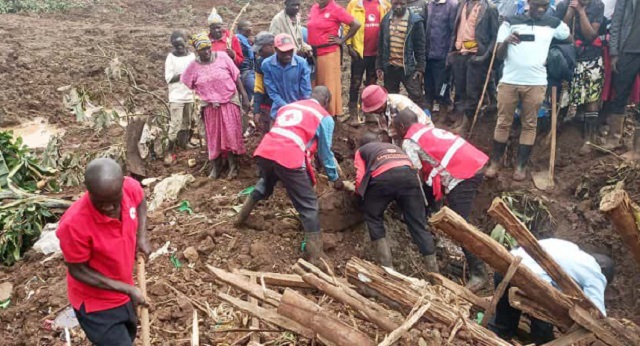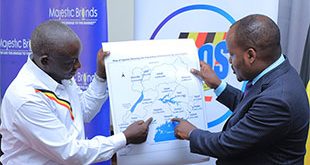
NGO says support for affected people of climate-related disasters in Mt. Elgon, Kasese still very little
COVER STORY | RONALD MUSOKE | Uganda is the 12th most vulnerable country to climate change out of 192 countries ranked accoridng to a report published in Kampala on Oct.30 by Oxfam, the UK-based global anti-poverty NGO.
The report titled “Climate and Fiscal Justice Scoping Study Uganda” also says Uganda is among the least prepared to deal with the climate crisis, ranking 163rd out of 192 countries in terms of readiness.
“This is a stark statistic for us,” said Francis Shanty Odokorach, the Country Director of Oxfam in Uganda, at the event to disseminate the report findings in Kampala.
The dissemination event was held 28 days before landslides struck six villages in Bulambuli District, in the Mt. Elgon area of eastern Uganda. According to a report by the Inzu Ya Masaba, a cultural institution for the region, up to 30 bodies had been recovered by Dec.05.
The report further indicated that 120 people are still missing, 22 individuals were injured, and 358 houses were buried by landslides. A total of 2,000 people have been displaced, with 1,800 currently housed in internally displaced persons (IDP) camps.
Weeks earlier, Oxfam-Uganda’s Odokorach had warned about many such challenges posed by climate change in Uganda. “Many communities that we do know, especially those in vulnerable areas like Mt. Elgon, Kasese, are already feeling the severe impacts of climate-related disasters, experiencing both environmental degradation and socio-economic losses,” he said, “Yet efforts to support communities to cope better are still very lean.”
Climate and fiscal justice study
The climate and fiscal justice scoping study provides a comprehensive analysis of the climate change challenge facing Uganda through a fiscal justice lens. Oxfam uses the term fiscal justice to describe the extent to which common citizens have power to query how public money is collected, spent and who benefits.
In case of climate finance, it analyses the magnitude of the climate change threat and how fiscal justice instruments can be leveraged for effective response. In this regard, Oxfam wants adequate public finance management systems to respond to climate change in terms of equity-responsive budgetary allocation and tracking of climate finance.
The Oxfam report analyses allocations of climate financing at the national level and to selected local governments and notes how effective tracking and reporting and institutionalisation of climate finance is weak, especially at the local government level despite local governments being on the front line of climate change.
The report also focuses on the sources of financing for climate change-related interventions in Uganda. It breaks down interventions in the national budget over a period of six years, clearly highlighting financing efforts and the gaps.
Odokorach said while national frameworks like the Certificate of Climate Change Responsiveness are in place, gaps in implementation, funding, and accountability persist. “We must tackle these issues together to protect the rights and livelihoods of those who are least responsible for it, yet are most affected by the climate change.
“The people who are most vulnerable experience the impact deeper, even here in Uganda, because of the inequality that exists.” Odokorach said climate change is not only an environmental issue, it is also a profound challenge to justice, fairness, and equity.
“I would imagine that the middle-class people, even where they live, is a little bit elevated and properly protected,” he said, “But within Wakiso and Kampala, when it rains, there are some people who will never even sleep at all for two days or three days, because their bedrooms become swimming pools. That is inequality.”
He said the government and many organisations are spending more on disaster risk reduction, adaptation, and response but more needs to be done to avert future floods, droughts and other adverse impacts of climate change that drive people into poverty.
How is Uganda’s climate finance spent?
More specifically, there is uncertainty about the money needed to tackle the climate crisis; where it comes from, how it is spent, and how it is accounted for. According to the study, over the last six years (2015 – 2021), Uganda is reported to have received in form of grants and loans about US$ 2.2 billion (Approx. Shs 8 trillion – about the same as was allocated to two important ministries; Education and Health, in the 2024/25 national budget).
With this money, the government is said to have implemented over 1,500 “climate-responsive” projects around the country. However, Dr. Anthony Mugeere(PhD), the principal investigator of the Oxfam study said it is difficult to quantify where exactly the “climate finance” is and what exactly it is doing.
“The issue of accountability is very critical because the money can’t keep flowing, whether it is coming to the government or the civil society,” he said. Dr. Mugeere who is a research fellow at the Advocates Coalition for Development and Environment (ACODE), a Kampala-based public policy think-tank, said although a lot is being done by NGOs and the government, there appears to be a lack of capacity within the government (Ministry of Finance and Ministry of Water and Environment) to track climate-related money.
Dr. Mugeere said government officials needs to understand elements of climate financing and accountability. “The ability to have these resources trickle down from the national to the local levels is important because that’s where the climate change impacts are being felt,” he said
According to the report, while climate finance in millions of dollars continues to flow into the country, a number of challenges remain,
The report notes that Uganda’s bureaucrats lack clarity on what climate finance is, do not have a functional framework for tracking and reporting on climate finance inflows from both domestic and international sources, and there is weak coordination of climate finance efforts among state and non-state actors.
Uganda’s climate finance sources
According to the study, Uganda’s climate finance comes from two main sources: the national budget and external international sources, including climate change funds and multilateral development banks (MDBs). The prominent multilateral and international institutions that lead in giving climate finance to Uganda include; the World Bank, the African Development Bank (AfDB) and United Nations agencies.
There are also bilateral financing mechanisms based on partnerships between the Government of Uganda and other governments such as those of Germany (through GIZ and KfW), France (through AFD), Japan (through JICA) and the United States (through USAID), among others.
Uganda’s top 10 bilateral sources of climate finance between 2015 and 2021 included; Germany, France, the United Kingdom, the United States, Denmark, Japan, Sweden, the Netherlands, Belgium and Norway.
The study found that Uganda’s climate finance comes into the country via three main types of instruments: grants, concessional debt and non-concessional debt. Research by the OECD and INKA Consult indicates that for the period 2015 – 21 around 50% (US$1.125bn) of all climate finance delivered was in the form of grants, compared with 44% (US$984m) through concessional debt instruments and 6% (US$126m) via nonconcessional debt instruments. There are also non-classified forms of climate finance such as funding that comes via technical assistance.
More adaptation than mitigation finance
Analysis of international climate finance inflows split by ratio of adaptation and mitigation finance for the period 2015–21 indicates a slight bias towards adaptation, with US$992m committed to adaptation compared with US$708m for mitigation and US$536m for cross-cutting projects.
On average, 30% of climate-marked projects between 2015 and 2021 had a “gender equality marker.” Of these, 28.3% had a gender marker of ‘significant’ while 1.8% had a gender marker of ‘principal.’ This indicates that, in general, gender has been mainstreamed as an important but not a principal objective of climate-related projects in Uganda, the study notes.
Lack of capacity
Dr. Mugeere (PhD), the principal investigator, noted that Uganda’s public financing of climate change is still meagre and is beset by structural challenges that hamper accurate quantification and reporting.
The Oxfam report added that a major challenge is the limited capacity among state and non-state actors including civil society to mobilise climate finance resources through preparation of bankable project proposals.
For example, a review of climate finance inflows to Uganda and its regional peers such as Kenya and Ethiopia indicates that Uganda still lags behind in attracting adequate funding because of lack of capacity to prepare bankable project proposals aligned to different climate finance funding mechanisms.
Comparisons between climate finance inflows reported by global organisations such as the OECD and those reported by the Government of Uganda also show big differences. This is partly attributed to a subjective interpretation of what constitutes climate finance, different methodologies and the inadequacy of government systems for tracking and reporting off-budget climate change projects implemented with direct support from development partners and non-state actors.
David Mugabi, the Director of Environmental Affairs and Commissioner, Environmental Sector Support Services in the Ministry of Water and Environment attributed the difficulty in tracking climate finance to the continuous failure to define “climate finance” even at the global level. He added that this has also been compounded by the government’s recent move away from allocating budgets to thematic areas to programmes.
“If, for instance, the Finance ministry releases money for roads, it means they are going to do drainage, they are going to plant trees, they are going to do walkways, and all these things you are talking about are either for climate adaptation or whatever,” he said.
Uganda’s climate finance unit
Another government official, Rebecca Nabatanzi Sserwanga, the Finance for Development Advisor in the Ministry of Finance told the meeting that the creation of a Climate Finance Unit (CFU) will institutionalise climate finance.
“It will be the coordination point,” she said, adding that the government is also working on a National Climate Finance Strategy with assistance from the government of Belgium. She said, already the Ministry has developed a National Green Taxonomy which defines activities, interventions and initiatives that are considered green or climate adaptation related.
Phillip Bakarikwira, the Chairperson of Climate Action Network-Uganda said Uganda needs its own Uganda-centric definition of climate finance for local partners to invest in green ventures.
“If we cannot unpack what climate finance is in a Uganda-centric manner, then we are wasting our time,” he said.
The report writers agree.
According to them, fast-tracking a local definition of climate finance will harmonise reporting and tracking, enhance civic participation in budget implementation and monitoring; establish independent climate finance accountability and tracking frameworks, and build the capacity of local government in climate finance accountability and tracking.
The study also calls for the enhancement of partnerships with bilateral agencies and multilateral development banks to increase adaptation flows for locally led adaptation action.
The study recommends a review and analysis of climate finance expenditure tracking, accountability and reporting and widening the focus of advocacy and monitoring beyond budgetary allocations to actual releases and disbursements of expenditure.
It also calls upon civil society to propose and advocate for stringent penalties for government agencies not complying with climate-responsive budgeting which is a governance system that mainstreams climate targets, commitments and considerations into decision-making on policies, actions and budgeting.
Cost of inaction
It is evident that the current scale of financing falls short of the challenges at hand and requires urgent intervention to support low-income countries that are already grappling with the dire effects of climate change, says the study.
In addition to climate effects, the rapidly growing population will further add to the impacts on the environment and the economy. If these are not addressed through investments in adaptation and mitigation, it is expected climate change could slow economic growth.
According to the study, safeguarding of water resources and replenishment of forests will be a critical part of adapting to climate change. Other areas to safeguard include the large public and private infrastructure projects that the country embarked on this past decade. “These projects must be able to withstand the climate changes to ensure longevity of public assets and avoid wasting tax payers’ money,” the report notes.
Estimates show that the cost of climate inaction is significantly higher over the long term than what is required to adapt infrastructure and the economy to deal with the rising pressures. By 2025, estimates show an annual cost of inaction in the range of US$3.1-5.9bn, which will rise to US$18-27bn in 2050, driven by unmet irrigation and biomass demand. The government of will in the next 15 years require new and additional finances to meet its growing cost of addressing climate change.
Uganda’s updated Nationally Determined Contributions (NDC) or national climate action plan embodies enhanced ambition in terms of targets in combating climate change. While the first NDC targeted a reduction of 22% in greenhouse gas emissions by 2030, the updated NDC ambitiously targets a 24.7% reduction over the same timeframe.
The updated NDC also includes 48 climate change adaptation interventions across sectors (agriculture, forestry, water, infrastructure, energy, risk management, manufacturing, industry, cities, built environment and disaster risk reduction (DRR), among others).
It is estimated that implementation of Uganda’s updated NDC will cost US$28.1bn over five years. Uganda has committed to mobilize domestic resources to the tune of US$4.1bn (unconditional interventions) to cover an estimated 15% of the total cost, while the remaining US$24bn (85%) will be sought from international sources in line with Article 9 of the Paris Agreement.
This, the report notes, implies that the achievement of the NDC targets is dependent on compliance with climate justice principles by richer countries honouring their pledges but Dr. Mugeere also points to the fickleness of geopolitics which the government must skilfully navigate.
“Our climate finance systems need to be strengthened to bridge the gaps between commitment and action, especially as the international adaptation finance to Uganda has fluctuated significantly in recent years,” Odokorach said, adding that: “A stable, transparent, and locally responsive financing approach is essential to achieving resilience.”
 The Independent Uganda: You get the Truth we Pay the Price
The Independent Uganda: You get the Truth we Pay the Price



